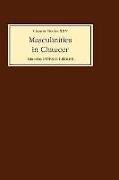Read more
Representations of masculinity in Chaucers works examined through modern critical theory.
List of contents
Part 1 "Canterbury Tales": mirth and bourgeois masculinity in Chaucer's Host, Mark Allen; homosociality and creative masculinity in the "Knight's Tale", Patricia Clare Ingham; mediating masculinities - erotic triangles in the "Miller's Tale", Martin Blum; performing the perverse - the abuse of masculine power in the "Reeve's Tale", Daniel F. Pigg; a wife, a batterer, a rapist - representations of "masculinity" in the "Wife of Bath's Prologue" and "Tale", Elizabeth M. Biebel; ambiguous brotherhood in the "Merchant's Tale", Jean E. Jost; sight and sexual performance in the "Merchant's Tale", Carol Everest; male movement and female fixity in the "Franklin's Tale" and "Il Filocolo", Andrea Rossi-Reder; doing what comes naturally - the "Physician's Tale" and the Pardoner, Glenn Burger; contrasting masculinity in Chaucer's "Tale of Sir Thopas", Jeffrey Jerome Cohen; the five wounds of Melibee's daughter - transforming masculinities, Daniel Rubey; reading Chaucer's "manly man" - the trouble with masculinity in the "Monk's Prologue" and "Tale", Michael D. Sharp; "Have ye no mannes herte?" - Chauntecleer as cock-man in the "Nun's Priest's Tale", Paul R. Thomas. Part 2 "Troilus and Criseyde": "slydyng" masculinity in the four portraits of Troilus, Stephanie Dietrich; "Is this a mannes herte?" - unmanning Troilus through Ovidian allusion, Maud Burnett McInerney; Troilus's "gentil" manhood, Derek Brewer.

